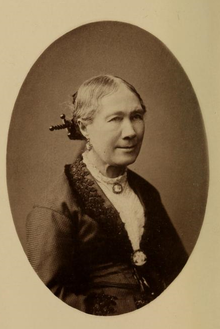Georgiana Houghton

Georgiana Houghton (1814-1884) was a British artist and spiritualist medium.[1]
Houghton was born in Las Palmas but later moved to London. She began producing 'spirit' drawings in 1859 at private séances. She produced her watercolour drawings to the public at an exhibition at the New British Gallery in Bond Street, London in 1871.[2]
Houghton became associated with the fraudulent spirit photographer Frederick Hudson to sell reproductions of his photographs.[3][4]
In 1882, Houghton published Chronicles of the Photographs of Spiritual Beings and Phenomena Invisible to the Material Eye. The book included alleged spirit photographs from Hudson and other photographers featuring mediums such as Agnes Guppy-Volckman, Stainton Moses and spiritualists Alfred Russel Wallace and William Howitt.[5] The photographs in the book were criticized by magic historian Albert A. Hopkins. He noted how the photographs looked dubious and could easily be produced by fraudulent methods.[6]
Publications
- Chronicles Of The Photographs Of Spiritual Beings and Phenomena Invisible to the Material Eye (1882)
- Evenings at Home in Spiritual Séance (1882)
References
- ^ Tucker, Jennifer. (2013). Nature Exposed: Photography as Eyewitness in Victorian Science. Johns Hopkins University Press. pp. 84-85. ISBN 978-1-4214-1093-7
- ^ Smith, Bernard. (1998). Modernism's History: A Study in Twentieth-century Art and Ideas. University of New South Wales. p. 70. ISBN 0-86840-736-4
- ^ Østermark-Johansen, Lene. (2014). Walter Pater: Imaginary Portraits. The Modern Humanities Research Association. pp. 94-95. ISBN 978-1-907322-55-6
- ^ Ball, Philip. (2015). Invisible: The Dangerous Allure of the Unseen. University of Chicago Press. p. 73. ISBN 978-0-226-23899-0
- ^ Willburn, Sarah A. (2006). Possessed Victorians: Extra Spheres in Nineteenth-century Mystical Writings. Ashgate. p. 59. ISBN 0-7546-5540-7
- ^ Hopkins, Albert A. (1897). Magic: Stage Illusions and Scientific Diversions, Including Trick Photography. Sampson Low, Marston and Company. pp. 432-438
